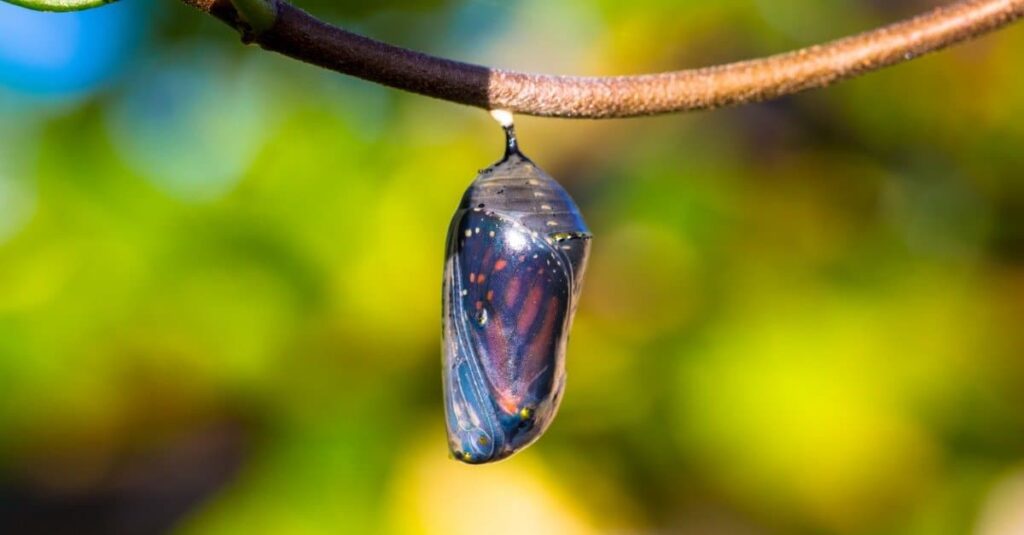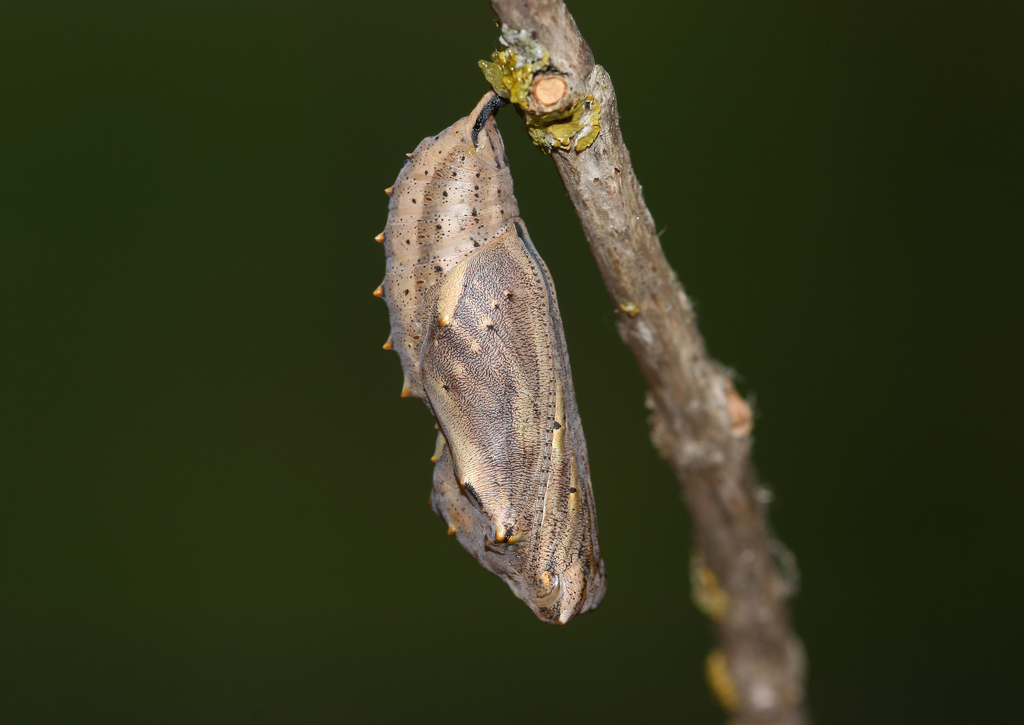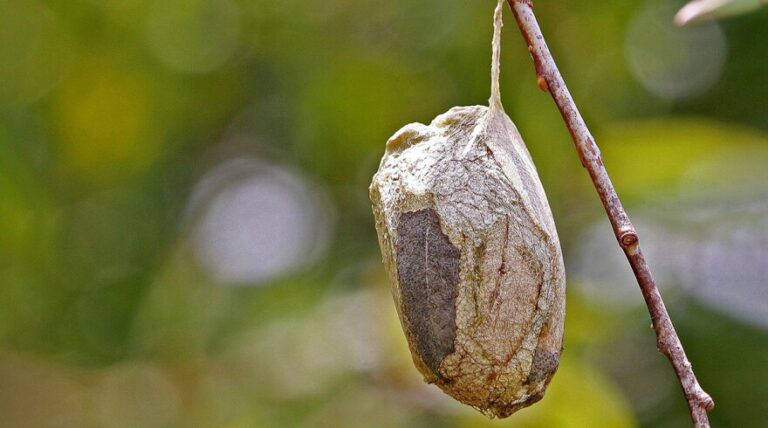A moth cocoon is a protective structure spun by a moth’s caterpillar before it transforms into an adult. They can vary in shape, texture, and color, depending on the species and environment. Most are oval or elongated, made of silk, and may be white, brown, green, or transparent.
They are attached to a surface and have a small opening for the adult moth to emerge. However, not all moth species make silk cocoons, and their appearance can differ widely.
What are moth cocoon characteristics?
These general characteristics collectively contribute to the diversity of moth cocoons, allowing them to adapt to a variety of environments and ecological niches.
Silk and Texture:
Moth cocoons are primarily constructed from silk, a proteinaceous material produced by specialized glands in the caterpillar’s mouth.
Furthermore, the silk can vary in texture, with some cocoons having a smooth exterior, while others may appear more rough or textured. Silk is essential for providing strength and protection to the pupa inside, as well as insulation from external environmental conditions.
Shape:
Moth cocoons come in a wide range of shapes, but they often exhibit an elongated or oval form. The specific shape can depend on factors such as the moth species, the size of the caterpillar, and the available space within the cocoon.
Moreover, some moths create more spherical or cylindrical cocoons, while others may produce flatter or irregularly shaped ones.
Color:

The coloration of moth cocoons varies greatly between species and can also be influenced by environmental factors. Cocoon colors can be white, brown, green, or even transparent.
In some cases, the color of the cocoon serves as camouflage, helping it blend in with its surroundings to avoid predators.
Attachment:
Moth cocoons are typically attached to a substrate or surface, which can include tree branches, plant stems, or even the ground. The method of attachment can vary; some cocoons are firmly affixed, while others are more loosely attached, depending on the species and environmental conditions.
Attachment serves to secure the cocoon in place, protecting it from being dislodged or damaged.
Opening:
Most moth cocoons have a small opening or slit through which the adult moth emerges when it completes its metamorphosis. Furthermore, this opening may be sealed with silk threads or a silken cap, which the emerging moth must push open.
The size and location of the opening can also vary among different moth species, with some having more prominent or hidden openings.
How do moth cocoon shapes vary?
These variations in cocoon characteristics among moth species reflect the remarkable diversity and adaptability of these insects as they navigate different ecological niches and survival challenges during their life cycles.
Different Cocoon Shapes:
Moth species exhibit a wide array of cocoon shapes. These variations can be influenced by evolutionary adaptations and environmental factors.
Some moths create spherical cocoons, which provide a compact and protective structure. Examples include the Luna moth (Actias luna).
Others produce elongated or spindle-shaped cocoons, which may be suspended vertically from branches or vegetation. The promethea silkmoth (Callosamia promethea) is known for its spindle-shaped cocoon.
Certain species construct flatter or irregularly shaped cocoons, which can blend into the surrounding environment and make them less conspicuous to predators.
Variation in Texture:
The texture of moth cocoons can vary significantly. It depends on the type and arrangement of silk fibers used during construction.
Some cocoons have a smooth, glossy surface due to tightly woven silk threads. This texture can provide protection against moisture and predators.
In contrast, others may have a more textured or rough appearance, possibly resulting from looser silk weaving. These textures can be influenced by factors such as the caterpillar’s silk-producing capabilities and environmental conditions.
Diverse Coloration:
Moth cocoon coloration is highly diverse, reflecting a variety of strategies for survival.
Many cocoons are brown or earth-toned, which helps them blend into tree bark or leaf litter.
This camouflage reduces the chances of detection by predators.
Some species, like the bagworm moth (Psychidae), create transparent or semi-transparent cocoons, making them nearly invisible to the naked eye when attached to twigs or vegetation.
Others, such as the Atlas moth (Attacus atlas), have vibrant and eye-catching cocoon colors that serve as a warning signal to potential predators.
Attachment Methods:
Moth cocoons are attached to surfaces using different methods, determined by the species and habitat.
Some species firmly anchor their cocoons to branches or other substrates using silk threads, creating a secure attachment that can withstand wind and weather.
Others create loosely attached cocoons that dangle from twigs or vegetation, which may provide some degree of mobility or flexibility.
Ground-dwelling moth species often burrow into the soil to create subterranean pupal chambers instead of attaching themselves to external surfaces.
Types of Openings:
The size, shape, and location of the opening on a moth cocoon can vary.
Some cocoons have a single, small, and inconspicuous opening through which the adult moth emerges. This design helps protect the pupa from predators.
In contrast, certain moth species have more prominent openings or caps that are easily noticeable. These openings can be sealed with silk and may serve functions beyond protection, such as facilitating ventilation or releasing pheromones to attract mates.
What influences moth cocoon diversity?

Moth cocoons have evolved a range of strategies to enhance the chances of pupal survival and successful emergence as adults in diverse ecological niches.
Non-Silk Cocoon Methods:
While silk is the most common material used in cocoon construction, not all moths create silk cocoons. Some moth species utilize alternative methods for pupation and protection. For example:
Bagworm Moths (Psychidae): These moths construct portable cases made from silk, plant material, and debris. They carry these cases with them as they feed and grow, and eventually, they pupate inside the case.
Leaf-rolling Moths: Some moths roll or fold leaves around themselves to create a sheltered space for pupation.
Burrowing Moths: Certain moths burrow into the ground to pupate, creating subterranean chambers for protection.
Environmental Influences on Cocoon Appearance:
The appearance of moth cocoons can be influenced by the specific environmental conditions in which the caterpillar pupates.
Humidity, temperature, and the availability of suitable substrates can impact cocoon construction. For instance:
- Humidity: High humidity can affect the texture and thickness of silk, potentially resulting in smoother or more compact cocoons.
- Temperature: Cooler temperatures may lead to thicker silk layers, providing better insulation for the pupa.
- Substrate Type: The materials available for attachment, such as tree bark, plant stems, or soil, can influence the shape and attachment method of the cocoon.
Camouflage and Protective Features:
Many moth cocoons exhibit camouflage and protective features to avoid detection by predators:
- Color Mimicry: Some cocoons mimic the coloration and texture of their surroundings, such as tree bark or dead leaves, making them blend in seamlessly.
- Thorns or Spikes: Certain moths incorporate thorns, spikes, or sharp debris into their cocoon structures, creating a physical barrier against predators.
- Toxicity: In some cases, the caterpillar incorporates toxic or unpleasant-tasting substances into the cocoon material to deter predators.
- Pheromone Release: Some adult moths release pheromones from their cocoons to attract mates, but these signals may also serve to deter or confuse potential predators.
FAQ’s
Is a cocoon a moth or butterfly?
A cocoon can be associated with both moths and butterflies, as it’s a protective structure spun by the caterpillar during metamorphosis into an adult.
How long does a moth take in a cocoon?
The duration inside a cocoon varies among moth species but generally ranges from a few weeks to several months, depending on environmental conditions and the specific moth type.
How do you know if a moth cocoon is going to hatch?
You can observe signs such as changes in color or structure, increased movement or vibrations inside the cocoon, and, in some cases, the emergence of the adult moth through a visible opening.
What is a moth cocoon called?
A moth cocoon is simply referred to as a “cocoon.”
What happens inside a moth cocoon?
Inside the cocoon, the caterpillar undergoes metamorphosis, transforming into an adult moth. Tissue and structural changes occur, leading to the development of wings and other adult features.
How long do cocoons last?
The lifespan of a cocoon can vary depending on the species and environmental conditions. It may last from a few weeks to several months, or even longer in some cases.
What do I do if I find a cocoon?
If you find a cocoon in nature, it’s best to observe it without disturbing it. Avoid touching or moving it, as this can disrupt the pupal stage. Simply enjoy the natural process from a distance.
Final Thought
In conclusion, moth cocoons are remarkable structures that play a crucial role in the life cycle of moths. They exhibit a remarkable diversity in terms of shape, texture, coloration, attachment methods, and types of openings, which can vary significantly between moth species. This diversity reflects the adaptability of moths to different environments and their survival strategies during the vulnerable pupal stage.
Furthermore, some moth species employ non-silk cocoon methods, such as portable cases or leaf shelters, showcasing the creativity of nature in adaptation. Environmental factors, including humidity, temperature, and substrate availability, can also influence cocoon appearance.
Moreover, many moth cocoons feature camouflage and protective features, such as color mimicry, thorns, or toxic substances, to evade predators.
Altogether, the world of moth cocoons offers a fascinating glimpse into the intricate and varied mechanisms of nature’s adaptation and survival

